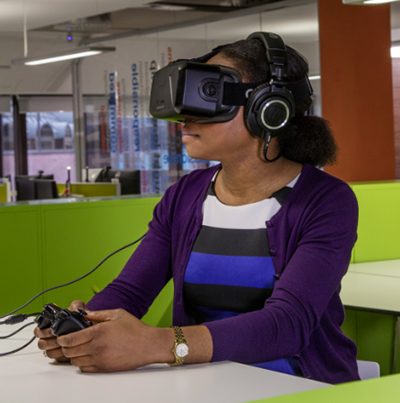Multi-disciplinary consultant Cundall has launched a virtual reality system that allows users wearing a VR headset to hear how a building will sound before it is built – creating an “auralisation” to go with the “visualisation”.
The tool, which Cundall has named Virtual Acoustic Reality (VAR), combines audio prediction modelling with the Oculus Rift VR headset and gaming-quality graphics, allowing clients and design team members to experience an immersive audio walk through of a building.
Cundall’s software combines the Oculus Rift with headphones so that users can not only see and move around inside a virtual building, but also hear how the space sounds relative to the location of the user.
Andrew Parkin, acoustics partner at Cundall, told BIM+: “Spaces sound different depending on where you are in them. What we have done is create a system that will present audio to clients in a way they can understand. They may still need numerical presentations and reverberation times, but this allows them to understand how a space will sound.
“We’ve evolved from a very boring, static audio-prediction based on numbers through to something which is based on graphics, is now dynamic, immersive and can be taken around the world to clients,” he continues.
Cundall believes that the ability to hear how sound actually changes as clients move through different spaces will facilitate decisions, such as on the choice of internal finishes, to be made based on experiential factors rather than just numbers on a page.

Cundall’s software combines the Oculus Rift with headphones. Image: Morley Von Sternberg
The firm predicts that its system is likely to have the most impact on the design of large commercial projects and schools.
Parkin continues: “We are careful to say to clients that this is a representation, not exactly how it will sound. I envisage it being used to look at three or four comparative sounds, so they can compare the various options and make a decision on cost.”
“This will demonstrate the importance of acoustics and will bring it up the food chain as people are able to engage and appreciate it,” he adds.
The system operates by programming different sounds onto a grid throughout the space that are played as the user (virtually) moves through them.
Parkin explains: “We map the sound onto a grid and each node point has a different file connected to it. At the moment there is a maximum of 99 node points, as the process takes a vast amount of computer power to calculate.”
Although competitors Arup and Max Fordham both have “sound labs” that include dedicated video screens to allow users to see inside a building, Cundall’s system allows this technology to be fully mobile, allowing the presentation to be taken to clients or the public.
At present Cundall have only modelled one iterative building, but intends to offer the tool to clients later this year.
“We haven’t used the system in anger yet as essentially this is a prototype. However, we have a number of clients that are very interested in it and hope to use it very soon,” concludes Parkin.
We have created a system that will present audio to clients in a way they can understand. They may still need numerical presentations and reverberation times, but this allows them to understand how a space will sound.– Andrew Parkin, acoustics partner, Cundall











